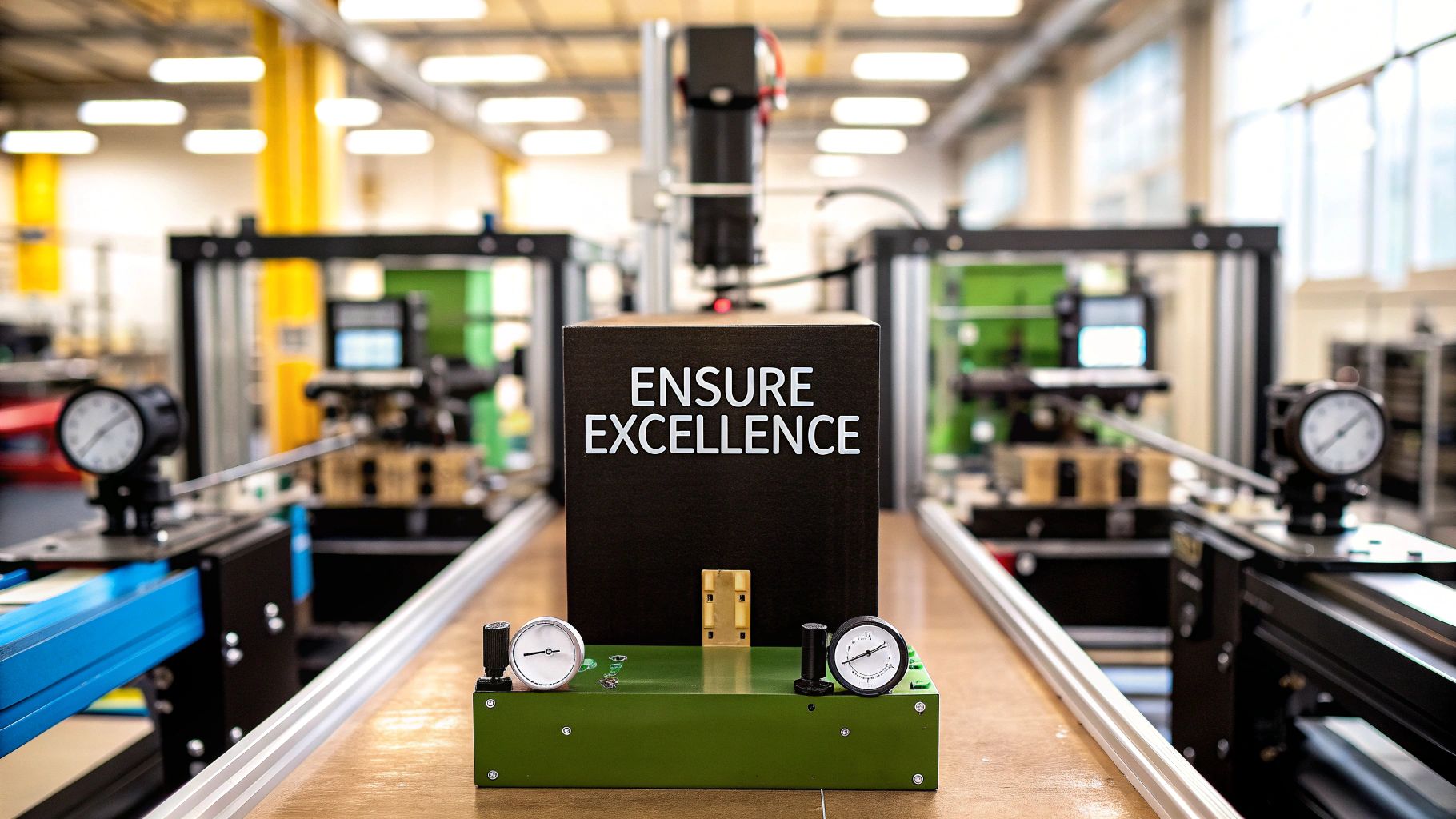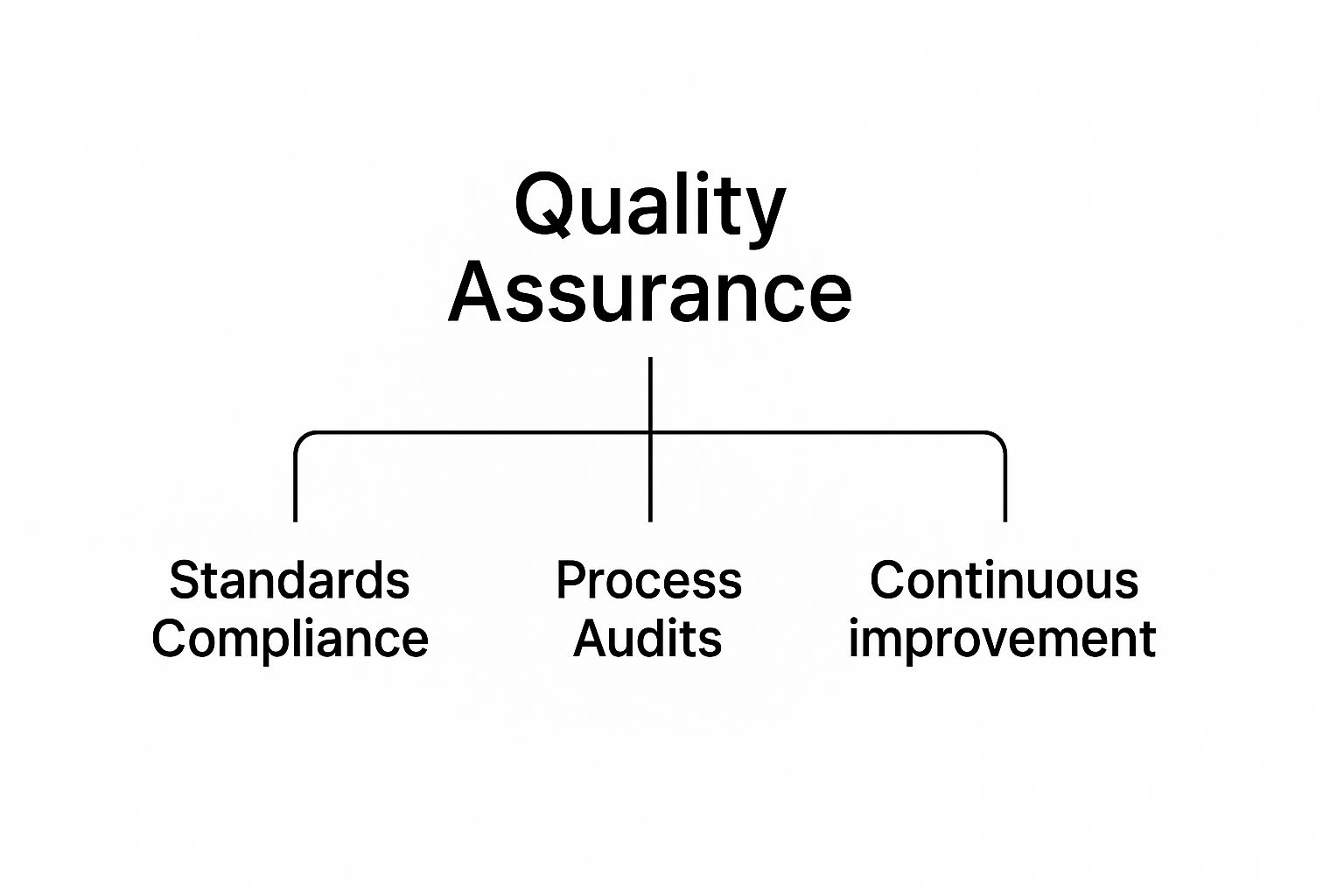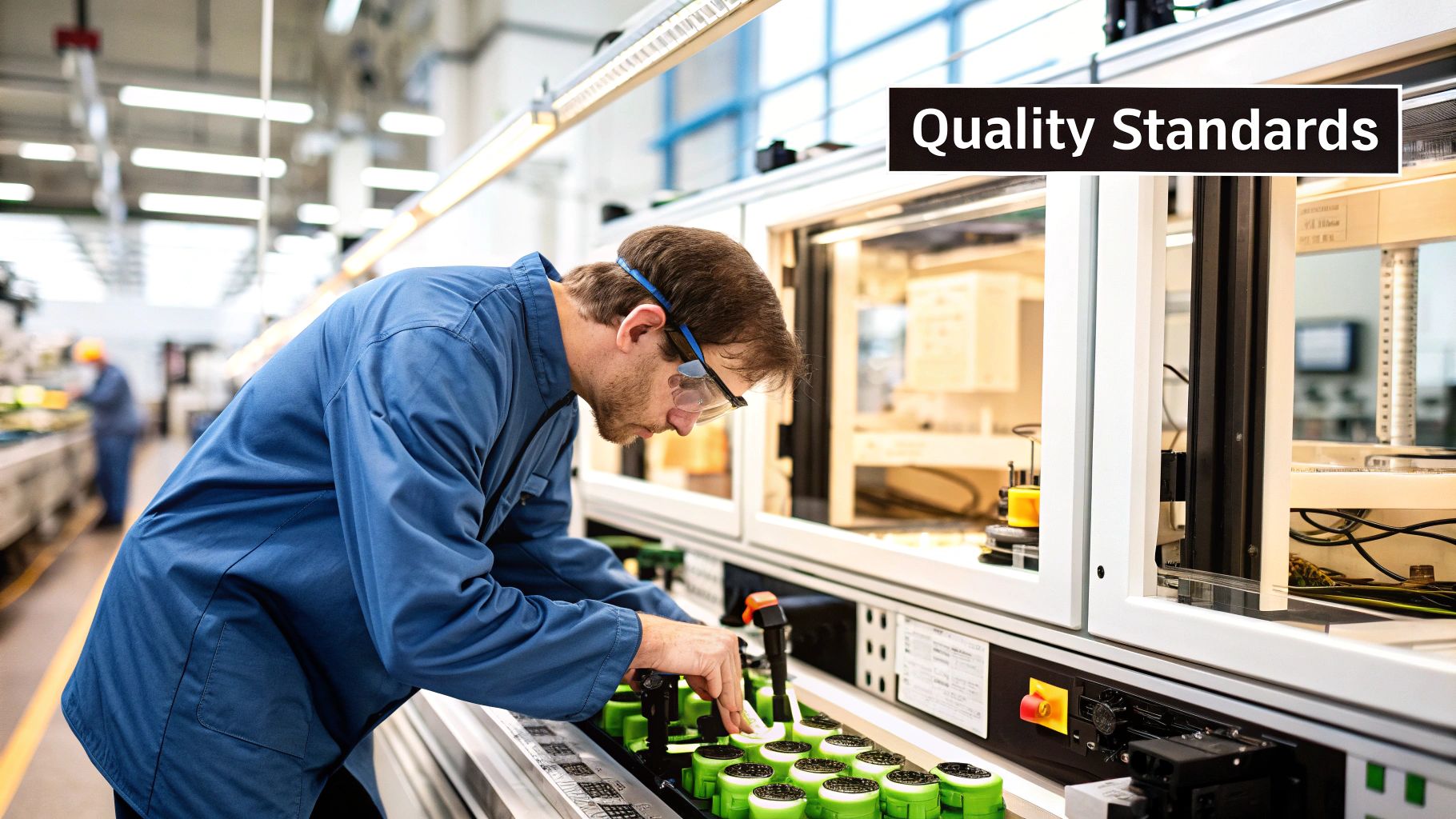Coming Soon: 3D Printing with AIS™ Antero® 800NA and 840CN03 Materials on the Stratasys F900Learn More

When considering "quality assurance," many envision an inspector examining a finished product at the end of an assembly line. This is a common misconception. True quality assurance in manufacturing is a fundamentally different discipline—it is a proactive system designed to prevent defects from occurring in the first place.
It is not about identifying mistakes; it is about establishing a framework where consistency, reliability, and excellence are integral to every step of the operation. This process-centric approach distinguishes leading manufacturers.
It is helpful to discard the notion of QA as a final checkpoint. A more accurate analogy is the architectural blueprint for a skyscraper. Long before construction begins, that blueprint ensures every stage—from the foundation to the spire—is engineered for complete structural integrity. This meticulous, upfront planning is what prevents catastrophic failures.
This methodology is distinct from Quality Control (QC), which is more akin to an inspector evaluating the finished structure for defects. QA is the system that prevents those defects from ever forming. This paradigm shift, from reactive inspection to proactive prevention, is the core of effective quality assurance in manufacturing.
The core philosophy of a robust QA system is to manage the process, not solely the final product. When processes are consistent, well-documented, and tightly controlled, the output naturally becomes more reliable.
This involves several key areas operating in unison:
By concentrating on these upstream factors, world-class companies cultivate a culture where excellence is the standard, not an anomaly. This systematic approach is especially vital as products increase in complexity and customer expectations rise. A comprehensive blueprint for manufacturing excellence extends beyond production lines, encompassing efficient operational management, which is often enhanced by effective facility management applications.
The true cost of poor quality is not limited to wasted materials or product recalls; it includes the loss of customer trust and the erosion of a brand's reputation. A proactive QA system is the single best investment a manufacturer can make in its long-term viability.
This diagram helps visualize how the core components of a quality assurance framework integrate, showing how a high-level strategy branches into standards compliance, process audits, and a commitment to continuous improvement.

As illustrated, QA is not a singular function but a governing strategy that relies on interconnected pillars. The consequences of inadequate implementation are significant. Between 2018 and 2025, product recalls in the life sciences sector increased by 115%. Medical device recalls alone cost the industry up to $5 billion annually.
These figures are not merely statistics; they are a stark reminder of the urgent need for proactive quality systems that prevent defects and protect end-users. For more in-depth analysis of modern manufacturing, please visit our guides at https://www.americanadditive.com/guides.

At first glance, global quality standards can appear to be a dense and intimidating set of regulations. However, it is more productive to view them as a shared language for excellence—a proven roadmap for building a system that delivers quality consistently.
At the center of this landscape is ISO 9001, the internationally recognized benchmark for a Quality Management System (QMS). It serves as the foundation upon which most other industry-specific standards are built.
Instead of prescribing exactly how a company must operate, ISO 9001 outlines what a successful QMS must accomplish. It is structured around core principles such as deep customer focus, committed leadership, and evidence-based decision-making. This framework provides manufacturers with the flexibility to design processes tailored to their unique business while adhering to a global benchmark for quality.
While ISO 9001 provides a comprehensive general framework, certain industries face risks of such magnitude that they require far more stringent controls. A malfunction in a consumer electronic device is an inconvenience; a flaw in an aircraft engine or a surgical implant could be catastrophic. This is precisely why sector-specific standards exist.
Consider this analogy: ISO 9001 is akin to a standard driver’s license, proving fundamental knowledge of road rules. Industry-specific standards are the additional endorsements required to operate a commercial aircraft or heavy-duty industrial machinery.
Key examples include:
These standards represent more than mere compliance. In industries where failure is not an option, they are essential for market survival and leadership.
Earning a certification for one of these standards is not simply about acquiring a document for display. It is a public declaration of your company's commitment to discipline and customer satisfaction. It signals to the market that you have a verified system for managing risk, auditing internal processes, and driving continuous improvement.
A formal quality standard provides the backbone for a proactive culture. It elevates a company from a reactive stance to a structured system that actively prevents errors, reduces waste, and builds trust with every product delivered.
This documented commitment to quality becomes a significant differentiator in a competitive marketplace. It proves that your approach to quality assurance in manufacturing is not a slogan but is woven into the very fabric of your operations. For organizations in demanding fields like aerospace, this level of quality is fundamental. You can see these principles in action by examining the advanced certifications held by leading additive manufacturers.
Ultimately, these standards offer a clear pathway to building a more resilient, efficient, and customer-focused business. They guide companies toward a QMS that not only passes an audit but actively propels the business forward, transforming quality from a cost center into a powerful competitive advantage.
Establishing high-level goals and quality standards is a critical first step, but the true test of any QA system occurs on the factory floor. The translation of abstract principles into the daily operations of machinery and personnel is accomplished through specific, proactive processes that integrate quality into every step.
These processes are the engine of quality assurance in manufacturing. They are the practical tools that transform a commitment to excellence from a mission statement into a tangible, measurable reality.
One of the most powerful tools in the QA arsenal is Statistical Process Control (SPC). At its core, SPC is about using data to monitor, control, and refine manufacturing processes in real-time. Instead of waiting to inspect a final product, SPC helps maintain the process itself within specified parameters.
Consider a bottling plant where the objective is to fill each bottle with exactly 500ml of liquid. Using SPC, one would not simply inspect a sample of bottles at the end of a production run. Instead, samples would be taken directly from the line at regular intervals, their volumes measured, and the results plotted on a control chart.
This chart reveals more than just the average fill volume—it illustrates the variation. If data points begin to drift toward an upper or lower control limit, it serves as a clear signal that a machine may require adjustment, long before it begins producing non-conforming products. This proactive monitoring reduces waste and ensures product consistency.
While SPC is excellent for maintaining ongoing process stability, another critical tool helps prevent failures before a product is even manufactured. This is Failure Mode and Effects Analysis (FMEA), a systematic method for identifying all potential problems in a product's design or its associated manufacturing process.
FMEA can be conceptualized as a structured, preemptive analysis where an engineering team methodically asks, "What could potentially go wrong?"
By scoring these risks, teams can focus their resources on preventing the most critical potential failures first. This forward-thinking approach is a cornerstone of robust quality assurance, especially in complex industries.
FMEA transforms quality assurance from a reactive, "find-and-fix" activity into a predictive science. It is about designing failure out of the system from the very beginning.
SPC and FMEA are powerful independently, but their true strength is realized when integrated into a broader system that also encompasses supplier quality, change management, and disciplined documentation. These elements must work in concert to create a truly resilient quality framework.
A strong, interconnected system includes:
When these processes are linked, they create a powerful feedback loop. Continuous Quality Assurance Process Improvement is vital for maintaining high standards and adapting to new manufacturing challenges.
Ultimately, operationalizing a quality system means making these processes a daily habit. From advanced 3D printing to traditional machining, the services of a certified manufacturing partner are often built around these very principles to guarantee part consistency and reliability.

Within any modern smart factory, it is evident that quality assurance is undergoing a significant transformation. It is no longer a reactive check at the end of the production line. Instead, it is becoming a predictive science, driven by vast amounts of data and intelligent systems. Technology is empowering manufacturers with the ability to foresee quality issues long before they manifest—a paradigm shift from merely catching mistakes after the fact.
Consider AI-powered vision systems that can identify microscopic defects with superhuman accuracy, or IoT sensors embedded within equipment, streaming real-time data to prevent the very failures that cause production flaws. This move toward data-driven insight is completely reshaping quality assurance in manufacturing for a new era.
Artificial Intelligence (AI) and Machine Learning (ML) are at the forefront of this new quality paradigm. These technologies possess an unparalleled ability to recognize patterns in massive datasets that would be imperceptible to human analysis. On the production line, this capability is transformative.
AI-driven computer vision systems can inspect thousands of parts per hour with unwavering precision. These systems do not experience fatigue or distraction; they can identify subtle flaws, such as faint scratches or minor color variations, that could easily elude a human inspector. The result is a dramatic reduction in defective products reaching the customer.
Machine Learning models can analyze historical production data to predict when a piece of machinery is likely to fail or begin producing out-of-spec parts. This predictive maintenance allows teams to intervene before a problem occurs, preventing costly downtime and quality degradation.
This technology, however, is not merely about faster flaw detection. It is about creating a system that learns and improves autonomously. As the AI processes more data, its predictions become more accurate, creating a continuous cycle of quality improvement. For this to be effective, data integrity is paramount, which is why understanding data parsing and its role in data management is crucial for extracting accurate insights.
The Internet of Things (IoT) provides the raw data that fuels these intelligent systems. By embedding sensors in machinery, workstations, and even the products themselves, manufacturers can create a complete digital representation—a digital twin—of their entire operation.
Each sensor functions as a nerve ending, constantly feeding information to a central system. These sensors can monitor critical parameters that directly impact quality.
This constant stream of data enables real-time process control. If a sensor detects that a machine’s temperature is deviating from its optimal range, the system can automatically adjust it or alert an operator to intervene immediately. This prevents entire batches of products from being compromised due to an undetected process anomaly.
These advanced technologies are enhancing quality assurance in manufacturing by significantly improving defect detection and process efficiency. For instance, AI-powered inspection systems can increase defect detection rates by up to 90%, while real-time data analytics have been shown to reduce non-conformance issues by 25%. Adopting machine learning for predictive maintenance also reduces downtime by approximately 30%, keeping production lines operating smoothly.
This level of technological integration is especially important in complex fields. For example, these principles are highly applicable in additive manufacturing, where layer-by-layer precision is paramount. Technology is no longer an add-on; it is becoming the central nervous system of modern quality management.

Additive manufacturing, commonly known as 3D printing, represents not just a new production method but a fundamentally different manufacturing philosophy. It inverts the traditional subtractive approach. Instead of removing material from a solid block, products are constructed from the ground up, one microscopic layer at a time.
This layer-by-layer process means quality cannot be an afterthought assessed at the end. It must be integrated from the very first layer. This process introduces a host of new variables that demand strict control, transforming quality assurance in manufacturing from a final inspection into a live, in-process activity.
Achieving consistent, high-quality results in additive manufacturing requires a delicate balance of material science, software precision, and environmental stability. A minor deviation in any of these areas can propagate through the entire build, compromising the integrity of the finished part.
The challenges are distinct from those in traditional manufacturing and necessitate a specialized focus:
These factors make it clear why traditional, end-of-line quality inspection is insufficient for this technology. To better understand this shift, you can explore the impact of 3D printing on production and supply chains in our related article.
Consider the production of a 3D-printed titanium medical implant, such as a custom hip joint. In this application, there is zero tolerance for error. The part must be biocompatible, possess specific mechanical properties, and match the patient’s anatomy with micron-level precision.
In additive manufacturing, quality is not a department; it's a data-driven process. Every stage, from initial powder analysis to final surface treatment, is a critical control point that determines the safety and efficacy of the final product.
To achieve this, a holistic quality strategy is required. It begins with certifying the source of the titanium powder, continues with real-time monitoring of the melt pool temperature during printing, and concludes with post-processing steps like heat treatment and surface finishing to achieve the required strength and texture. Every step is tracked and documented to ensure complete traceability.
This level of control is also being advanced by other technologies. For instance, augmented reality (AR) and virtual reality (VR) are becoming powerful tools for QA training and inspection. Some companies are developing mixed-reality platforms that guide technicians through complex assemblies or allow for virtual inspection of digital models, catching design flaws before any material is used. You can discover more about these emerging trends in quality management.
Ultimately, true mastery of quality in additive manufacturing means mastering the entire digital thread—from the initial design file to the final, functional part. It is a proactive, data-intensive approach that ensures excellence is not merely inspected for, but engineered into the product from its very foundation.
We have covered significant ground—from high-level frameworks to the detailed standards that drive a world-class manufacturing operation. As these concepts are synthesized, several practical questions often arise. Let's address some of the most common inquiries from teams beginning their quality journey or seeking to enhance their existing systems.
This is perhaps the most frequent point of confusion, and its clarification is fundamental.
Quality Assurance (QA) is the comprehensive system established to achieve a quality outcome. It encompasses activities like sourcing certified materials, meticulously developing and validating processes, training personnel, and ensuring equipment is properly calibrated. It is the proactive, process-focused work performed before production begins to prevent defects.
Quality Control (QC), in contrast, is the inspection or measurement performed on a finished product or component. It is a reactive, product-focused check to identify any defects that may have occurred despite the QA system. Both are necessary for a superior result, but it is critical to remember: QA builds quality in, while QC inspects for defects.
A substantial budget or external consulting team is not a prerequisite for building a meaningful quality program. For smaller organizations, the key is a strategic focus on high-impact activities.
Begin by documenting core processes. A complex system is unnecessary; clear, simple checklists are remarkably effective. Next, identify one or two key performance indicators (KPIs) that are most critical to your business—for example, the product return rate or the volume of scrap material generated. Concentrate initial efforts there. Most importantly, empower every team member with responsibility for the quality of their own work. This fosters a culture of ownership that is invaluable.
A world-class quality system does not have to be expensive, but it must be intentional. The objective is to start small, demonstrate value, and build the program incrementally over time.
Traceability functions as both an ultimate insurance policy and a powerful data-gathering tool. It is the ability to track every part, material batch, and process step from its point of entry into your facility to the final product in the customer's possession.
In the event a defect is discovered post-delivery, robust traceability enables immediate root cause analysis. Was it a specific batch of raw material from a supplier? A single machine that deviated from its calibration? A particular production shift? This capability allows for immediate problem containment, dramatically limiting the scope and cost of a potential recall.
For any organization in highly regulated fields such as aerospace, automotive, or medical devices, it is not merely a best practice—it is a non-negotiable requirement for safety and compliance.
No, formal certification to ISO 9001 is not required to have an excellent QA program. However, it is the globally recognized gold standard for a Quality Management System (QMS).
Many companies pursue certification to publicly demonstrate their commitment to quality, and it often serves as a prerequisite for securing contracts with large customers or within certain industries. The true value, however, is not the certificate itself, but the discipline of implementing the framework. Any company can adopt the core principles of ISO 9001—a sharp focus on the customer, a process-driven approach, and evidence-based decision-making—to build an outstanding QA system, even without undergoing the formal certification audit.
At American Additive Manufacturing LLC, we do not simply inspect for quality; we build it into every layer of every part we produce. Our ISO 9001:2015 and AS9100D certifications are more than credentials—they represent our unwavering commitment to excellence and precision. Whether you require rapid prototypes, complex production parts, or on-demand spares for the aerospace and defense sectors, our end-to-end additive manufacturing services ensure your projects meet the highest possible standards. Partner with us to reduce lead times, fortify your supply chain, and accelerate your time to market. Explore our advanced manufacturing solutions at https://www.americanadditive.com.